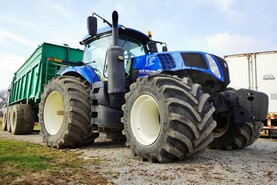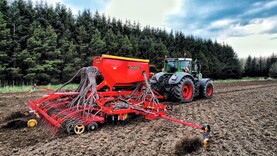A series of short presentations at the recent National Tillage Conference provided an update on current tillage-related research at Teagasc. These presentations also introduced us to young and very capable researchers. This article summarises the five presentations.
New aphid resistance mechanism
Aphid control and BYDV have become very real issues in the past few years. Research has told us that a proportion of our grain aphid population carries partial resistance, also known as knockdown resistance (kdr) to the frequently used pyrethroid insecticides.
This is only partial resistance and it is generally accepted that these sprays can still kill such aphids using full rates.
However, there have been a number of instances where full control was not achieved and significant BYDV resulted. So the question was posed as to the possible existence of a second type of resistance in some aphids.
This question was addressed in some recent work conducted by Lael Walsh at Teagasc in Ashtown. She looked at the level of control using Lambda-cyhalothrin (Karate) on of a number of populations of grain aphid, all of which were known to have kdr resistance.
Of the different populations tested, only two could be controlled using a standard rate of the insecticide. Some of the populations showed considerable resistance, which indicated that a second resistance mechanism could be at work.
The mechanism suspected was metabolic resistance. Where this is present, enzymes in the aphids break down the aphicide before it can be absorbed to cause death. This theory was tested by adding another ingredient (PBO) with the insecticide, as this blocks enzyme detoxification.
Where PBO was added, the efficacy of the aphicide was much better, demonstrating the presence of metabolic resistance in some of the populations.
This work verifies that we now have two resistance mechanisms evident in grain aphid populations – metabolic and kdr. It also helps to explain occasional field failures in situations where a pyrethroid insecticide was used.
Traits for the future
Petra Kock-Appelgren explained some of the objectives of the Virtual Irish Centre for Crop Improvement (VICCI) project, which is targeting genetic improvement in crop varieties suitable for Ireland.
This is a big collaborative project with five institutions examining mechanisms that help fertiliser efficiency, crop protection, environmental stress or import substitution.
Current research is searching for genes that may be useful to bring tolerance to waterlogging in winter barley and perennial ryegrass. Other work is looking at differences between varieties for nitrogen use efficiency.
Petra reported that research to date has found certain varieties which can make better use of lower nitrogen applications and that could be useful in time.
Other work has shown that some wheat varieties are less adversely affected by higher septoria infection levels. Knowledge of such differences between varieties could be very useful for future selection.
Much of the early stages of this work is using small plots in the field in conjunction with molecular and genetic research. Petra commented that the benefits will mainly come through plant breeding over time. But there may be some earlier benefits relating to nitrogen use efficiency or responsiveness to disease control.
Six-rows need more PGR
With six-row hybrids having different optimum components of yield, and higher yield potential according to the recommended list, it is valid to ask if their husbandry should be different to the more conventional and well-proven husbandry for two-row types.
This was the topic of a research project conducted by Rob Beattie. Trials using both variety types at appropriate seed rates, Tower two-row and Volume six-row, were sown at Oak Park and Edinburgh. Five different fungicide programmes were tested, along with two plant growth regulator (PGR) programmes.
Despite some local differences, Rob reported that there was no significant difference between the two varieties or in their responsiveness to fungicide treatment.
However, there was significant difference between the two varieties in their response to plant growth regulation.
Not surprisingly, Volume showed a much higher response to PGR as it had much more lodging.
Given the relatively similar performance of two- and six-row types on farms in recent years, Seamus Kearney from the variety testing section at the Department of Agriculture said that recommended list trials will look in greater depth at this performance difference in 2018.
Measuring soil structure
There is increasing awareness of the challenges of maintaining good soil structure in tillage fields given our challenging soil conditions and heavy modern machinery.
Having a method to evaluate this would be useful, especially for farmers who accept that it needs to be improved to sustain productivity into the future.
Jer Emmet-Booth has been working on such a method for a few years. He reminded us that compaction is about the compression of the soil particles to squeeze out the spaces that would otherwise provide pores for air, root and water movement.
He has been examining the Scottish VESS system to evaluate soil structure. As part of his research, he deliberately compacted areas in two fields, one heavy and one light, to different degrees to assess if the system could detect and differentiate between the different compaction levels.
While the damage produced in the experiment could not be described as bad, the system did manage to show visual differences, as shown in how the soil breaks down, with high compaction levels giving a higher VESS score to indicate poorer structure. And the degree of damage was worse on the heavier soil.
Jer pointed out that the VESS method is not really about generating exact numbers, but rather to provide an indicator at points in time.
He reinforced the point that structure damage cannot be removed by actions such as subsoiling and so the key thing is to protect the soil or to act over time to improve it.
Ramularia leaf wetness link
Ramularia is a serious threat for barley growers. It is not a problem every year, but it can be a serious yield robber when it strikes.
It is generally only seen post-flowering and after all fungicides have been applied. This disease is becoming increasingly important following reports of resistance to many of the major fungicide families.
Joe Mulhare has been working on this disease with the intention of assessing a risk prediction model to guide growers on fungicide requirement long before the disease can be seen. It seems that it is the weather during the GS30 to GS32 period that sets up the infection risk.
If we get more than 7,500 minutes (125 hours) of wet leaf during that critical period, the risk from the disease is deemed to be high later in the season. If this is between 4,000 and 7,500 minutes (66-125 hours), the risk is deemed to be medium.
That said, Joe’s trials concluded that there were differences between the varieties tested, that a good standard fungicide programme was adequate for the high risk and that a lesser control programme can be used where risk is medium to low. However, chlorothalonil is still the major control tool.






 This is a subscriber-only article
This is a subscriber-only article









SHARING OPTIONS: